Imagining crises: a thought exercise for students at Mines Paris – PSL
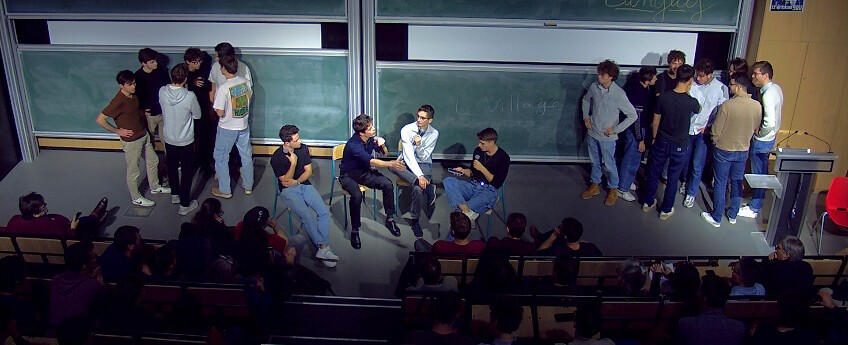

This year, the question asked was: “What crises in an all-electric France?” A topic at the heart of current concerns, at a time when the massive electrification of our societies appears to be a central lever for the energy transition, but also raises challenges in terms of security and resilience.
This course immerses engineering students in an in-depth reflection on how crises emerge and spread. In groups, they must design crisis occurrence scenarios, specifying the phenomena involved, their spatial and sectoral context, as well as the interdependencies at work.
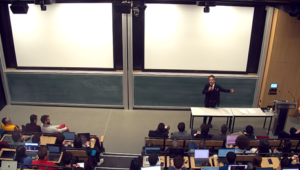
Inaugural lecture by Étienne Klein, research director at the CEA, on the importance of thought experiments in science and engineering
The course began with an inaugural lecture given by Étienne Klein, research director at the CEA, on the importance of thought experiments in science and engineering. The students were then supervised by 18 experts from various fields: risks and crises, industrial and energy processes, scriptwriting and storytelling, scenography.
Experts and students look back on this immersive experience, which gave them a better understanding of the fragilities of an increasingly connected and interdependent world.
To meet the challenge they faced, the students explored a variety of scenarios, highlighting both technical and societal issues. According to the course’s pedagogical supervisors, Aurélien Portelli and Justin Larouzée, “the thought experiment is an approach that makes it possible to question reality and invent other realities. In the context of this course, it is a question of imagining potentially devastating events or phenomena, which is an absolutely necessary preliminary step if we hope to be able to mobilize the means to prevent their occurrence. The students must describe the genesis, occurrence and immediate effects of a crisis without considering either the long-term effects or the management/resolution of the event.” […]
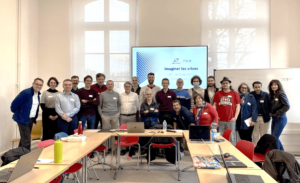
Supervisory team of the course ‘Imagine the crises’ 2025
Critical scenarios have emerged, according to the experts. General Goupil, an expert in crisis planning and management, emphasizes the quality and diversity of the approaches adopted by the students: “The way in which the students constructed their crisis scenarios shows that they have taken into account the structural vulnerabilities of an ‘all-electric’ France. Alain Quiot, an industrial safety expert at ICSI (Institute for an Industrial Safety Culture), highlighted several major industrial risks associated with an all-electric France: “The decarbonization of overseas departments and territories; resilience to widespread failures affecting essential network components; the place of small-scale nuclear power (SMR) in the electricity mix of the transition; the risks to low-carbon technologies of a heavy dependence on non-European manufacturing […] These risks are very relevant and show that the complete electrification of the country requires resilient infrastructure and rigorous preparation to avoid major crisis scenarios.”
Jean-Yves Bourmaud (P91), R&D expert at RTE, also emphasized the relevance of the students’ reflections: “I was struck by the curiosity, creativity and maturity shown by the students. They were able to balance their creative sensitivity with the scientific plausibility of the narrative.” He also noted a recurring trend: “The vast majority of groups formulated scenarios on a technical basis (energy crisis) but leading to a social (and sometimes political) crisis.”
Far from being solely a technical exercise, the course “Imagining Crises” immerses students in a broader reflection on the complexity of systems and the importance of Organizational and Human Factors (OHF). Alain Quiot emphasizes the fundamental contribution of this teaching: “The exercise of anticipating crises in an all-electric France goes far beyond a simple exercise in technological foresight. It is a powerful tool for raising awareness of the issues of safety culture and FOH, which are essential elements in the management of industrial risks.” Jean-Yves Bourmaud agrees: ”It is increasingly necessary to bring the basic sciences face to face with the humanities and social sciences in order to broaden the range of viewpoints.”
The pupils also had to translate their scenarios into hard-hitting presentations. Elisa and Lucie, representatives of group 7, developed a scenario in which a massive solar storm hits an all-electric France. They explain: “We started by choosing the nature of the crisis that would occur in our scenario: a massive solar storm (on the order of the one that burned down the telegraph in the 19th century.) Then we considered several contexts in which this storm could occur. It seemed to us that the crisis and its consequences would be even more striking when initially everything is going for the best in the best of all possible worlds, and that is ultimately what we chose as the scenario. In a future where the European Union has had a jolt in the face of the geopolitical context, where it has once again become a prosperous and sovereign area and where France has succeeded in meeting the challenge of the energy transition by switching to all-electric, a solar storm is detected, and within a few hours it hits the north of the territory, destroying the region’s transformers. The country finds itself completely paralyzed, and, unfortunately in this future where we no longer know how to manage serious crises, we no longer know how to manage them, which makes the consequences of the solar storm dramatic.”
They note that the exercise allowed them to develop technical and human skills: ”We had to grapple with describing what an all-electric France could actually look like and what it would entail. With what means of production and according to what mix? In addition, we learned a lot about solar storms and their consequences. We alternated working methods (brainstorming all together, in-depth research in small groups, individual work) to maintain a fun and efficient work dynamic. Our discussions with the experts were very rewarding and we believe that they will encourage us, in the future, to favor human contact within the company to ask questions and break deadlocks, rather than getting stuck alone when faced with a problem. The work on scenario building was also very interesting, and in the uncertain context we are currently experiencing, it may be particularly useful to mobilize these methods to better manage risks in our future professions.”
The theatrical work carried out under the direction of Arnaud Straebler, an expert scenographer, added an essential dimension to the presentation of the scenarios. The staging allows the students to transcend the technical analysis and add an emotional dimension: “To help the students translate their scenarios into powerful and engaging sketches, I first made sure to respect the original intention they had imagined, based on their written scenario. Then, I discussed the different staging possibilities with them, seeking to preserve the central issue they had defined, in order to highlight it during the final presentation. […] We then worked on the script of the presentation, refining the dialogues and actions to make them as impactful as possible. Finally, rehearsals were held to ensure that the final presentation was fluid, dynamic and had a strong impact on the audience.”
Arnaud Straebler also highlights the challenges encountered: ”The first challenge was to synthesize a complex and detailed situation in just five minutes, while retaining the essence of their message. The second challenge was to free up their creativity even more, particularly with regard to the design of the stage plan, to come up with dialogues that were both credible and plausible.”
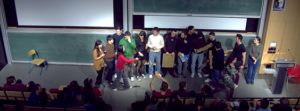
Presentation of crisis scenarios in the form of sketches
At the end of this work, the presentation of the different scenarios took on a particularly rich form thanks to the forum, one of the deliverables of the course. As an exercise in free expression, the forum allowed students to share a common reflection on the values underlying the scenarios presented. This presentation constitutes a manifesto, allowing the students to express their view of the future through the prism of the crises they have imagined.
The presence of a graphic facilitator, Frédéric Debailleul, who visually captured the students’ exchanges and reflections, also played a key role in this restitution. Thanks to his drawings, he made it possible to visualize the issues addressed in a creative and accessible way. This collaboration between theater and graphic illustration offered a rich and varied restitution, thus providing a global understanding of the imagined crisis issues.
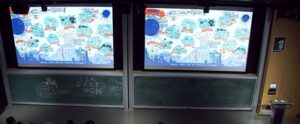
This collective work opened up a space for joint reflection, while leaving plenty of room for the expression of individual sensitivities. The exercise is a structuring one for the future engineers of Mines Paris – PSL. General Goupil emphasizes the fundamental contribution of this exercise: “The exercise highlighted the collective creativity of the students of the École des Mines, with original and well-constructed scenarios.” This teaching thus prepares them to better anticipate the crises of tomorrow. Alain Quiot confirms this: “This exercise anchors the culture of safety at the heart of engineering training. It reminds them that their mission is not limited to designing high-performance systems, but also to guaranteeing their robustness in the face of the vagaries of the real world. A key skill at a time when energy, climate and technological challenges are intensifying.”
Matthieu Mazière, Director of Studies for the Civil Engineering Cycle, concludes: “On the one hand, it is sad to think that our students will have to live in a world that is now bouncing from crisis to crisis, and on the other hand, it is comforting to see the maturity and lucidity they are already showing in the face of this state of affairs, as well as the dynamism and joy in working together that they maintain despite everything.”
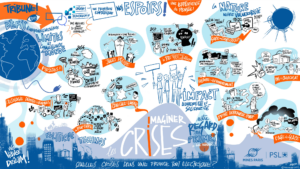
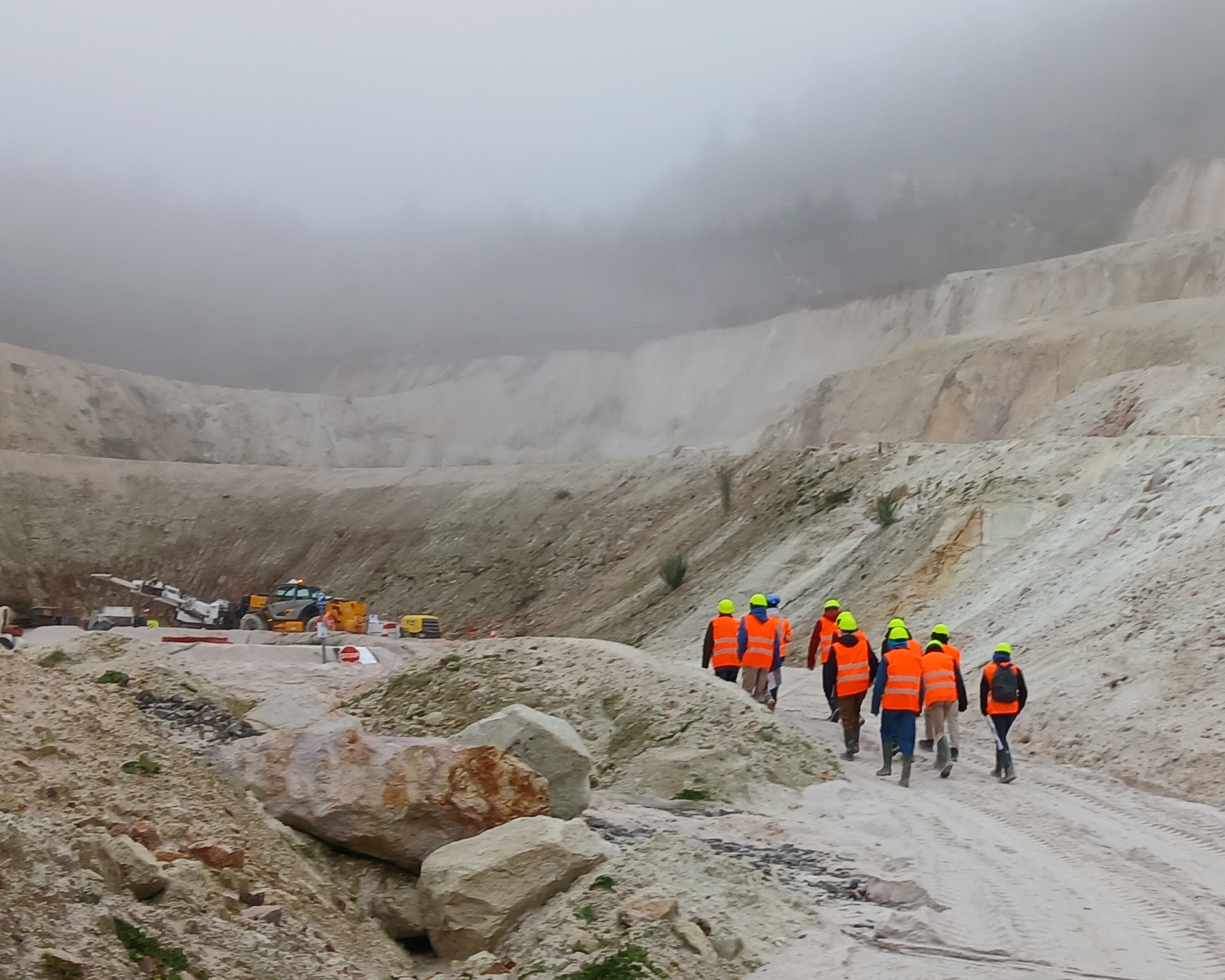
In a world of perpetual technological transition, society needs engineers capable of understanding, supporting and designing complex systems, while gu...